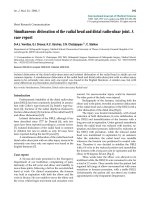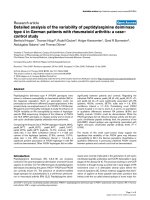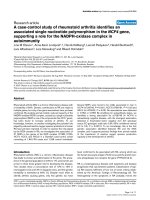Báo cáo y học: "A case of bowel entrapment after penetrating injury of the pelvis: don’t forget the omentumplasty" potx
Bạn đang xem bản rút gọn của tài liệu. Xem và tải ngay bản đầy đủ của tài liệu tại đây (786.14 KB, 3 trang )
CAS E REP O R T Open Access
A case of bowel entrapment after penetrating
injury of the pelvis: don’t forget the
omentumplasty
Ewan D Ritchie
1
, Eelco J Veen
2*
, Jan Olsman
3
and Koop Bosscha
3
Abstract
Bowel entrapment within a pelvic injury is rare and difficult to diagnose. Usually, it is diagnosed late because of
concomitant abdominal injuries. It may present itself as an acute intestinal obstruction or, more commonly, as a
prolonged or intermittent ileus. Therefore, one should be aware of this late complication and primarily take
measures for avoiding bowel entrapment. This report describes an unusual case of bowel entrapment within a
pelvic fracture after a penetrating injury, and dis cusses options for preventing such a complication.
Introduction
Bowel entrapment within a pelvi c injury is rare and dif-
ficult to diagnose. Usually, it is diagnosed late because
of concomitant abdominal injuries. It may present itself
as an acute intestinal obstruction or, more commonly,
as a prolonged or intermittent ileus. Therefore, one
should be aware of this late complication and primarily
take measures for avoiding bowel entrapment.
A twenty-eight year old man was involved in a car
crash sustaining a traumatic injury to the lower abdo-
men. A metal roadwork pole broke and went through
the engine and speared the patient. The pole went in at
his left groin penetrating his abdomen, and came out on
the other side through his sacral bone. (Figure 1) After
freeing the patient by cutting the metal pole on both
sides, he was transferred to our hospital with the pole in
situ. At the emergency department, the patient was
examined according to the ATLS principles. The patient
had sustained no further damage to the body and was
hemodynamically st able. There was no medical or surgi-
cal history. There was no neurovascular damage and the
function of the perineal region was intact. Trauma
radiographs showed the penetrating corpus alienum
through the sacral bone. The pelvic ring was intact. A
CT scan of the abdomen with contrast confirmed the
injury but did not show any bowel or vascular injury
(Figure 2).
The patient was transferred to the OR and was
removed by pu lling the pole ventrally without any force.
Faecal contamination was diagnosed by exploring the
sacral wound. The patie nt remained hemodynamic
stable. An explorative laparotomy was performed and
only showed a perforation of the rectosigmoid due to
pentrating injury of the pole; a Hartmann’ s procedure
was performed. The central sacral bone defect had a
diameter of 2 inches, sparing S1 and S2 foramina and
was left untouched. The vascular structures and the ure-
thra were investigated peroperatively, and showed no
damage. Postoperatively, t he patient went to the ICU.
Physical examination postoperatively revealed no new
injuries and no neurological deficit. After transfer to the
surgical ward, the patient was mobilized. In the early
postoperative period, he was diagnosed as having an
ileus, which was treated with a nasogastric tube and IV
fluids. After 8 days, he s howed bowel activity and toler-
ated fluid intake. Eventually, he was discharged after 21
days. Two weeks after discharge, he presented to the
emergency department because of nausea, anorexia and
vomiting. He h ad lost 10 kg in weight. His stomy had
been intermittent productive. P hysical examination
revealed a normal temperature and a regular pulse. The
abdomen was nontender with distention and show ed a
paucity of bowel sounds. Laboratory tests were unre-
markable. He was admitted and received a nasogastric
tube and IV drip. A CT scan showed a significant
* Correspondence:
2
Department of Surgery, Amphia Hospital, Breda, The Netherlands
Full list of author information is available at the end of the article
Ritchie et al. Scandinavian Journal of Trauma, Resuscitation and Emergency Medicine 2011, 19:34
/>© 2011 Ritchie et al; licensee BioMed Central Ltd. This is an Open Access article distributed under the terms of the Creative Commons
Attribution License ( which permits unrestricted use, distribution, and reproduction in
any medium, provided the original work is properly cited.
distention of the ileum and jejunum, demonstrating an
obstruction in the pelvic area (Figure 3). At laparotomy,
an obstructed distented small intestine was seen due to
a segment of small intestine herniated in the perforated
sacral bone. Eventually, an end-ileostomy was installed
because of the distention of the small intestine and,
also, an omentoplasty was performed to fill up the
defect in the sacral bone. The postoperative period was
seriously complicated by a pulmonary embolism which
was treated with anticoagulants, although the patient
received a low mol ecular weight heparin during the first
six weeks after the traum a. The compli cation was prob-
ably caused by prolonged bedrest. A normal diet was
started soon. At follow-up, he had gained sufficient
weight. Restorative surgery will be planned in the near
future.
Discussion
Penetrating trauma to the abdomen can cause severe
injuries to multiple organs, but entrapment of the bowel
within a pelvic fracture is rare.
In case of bowel entrapment in a fracture, there must
be a substantial displacement of the fracture and disrup-
tion of tissue. Bowel entrapments have been recorded
occasionally in sacral, iliac wing and acetabular frac-
tures. A paralytic ileus is a known complication of
abdominal surgery and a prolonged recovery is com-
mon. However, symptoms can mask true mechanical
obstruction. A paralytic ileus occurs in 5.5 to 18 percent
of pelvic fractures, lasting an average of 2.6 days [1-3].
Literature shows that the diagnosis is delayed by an
average of two weeks, presumably due to difficulty in
differentiating entrapment from the more common
paralytic ileus. Therefore, entrapment of the small bowel
can be easily overlooked when the potential cause of
symptoms are not recognized. If an ileus with a pelvic
fracture persists for a lengthy period of time, an occult
bowel injury such as entrapment at the fracture site
should be considered. Radiological techniques can be
useful in making the diagnosis. Plain radiographs can be
Figure 1 Patient with metal road work pole presented at the
ER at a spine board.
1
2
3
Figure 2 Coronal view. Penetrating object caudal to the bladder. 1
bladder. 2 spine. 3 penetrating object.
1
2
3
Figure 3 CT scan with axial view. Sacral fracture with entrapment
and distention of the ileum and jejunum. 1 sacral fracture. 2
distended entrapped ileum 3. distention of the small intestine.
Ritchie et al. Scandinavian Journal of Trauma, Resuscitation and Emergency Medicine 2011, 19:34
/>Page 2 of 3
helpful in identifying obstructions. Oral contrast studies
can be misleading due to normal transit times for the
passage of contrast, even in case of a herniated bowel. A
CT scan with enteric contrast can demonstrate a her-
niated or entrapment bowel in the fracture [4,5].
To treat the problem and avoid recurrent obstruction an
omentoplasty was performed to seal the pelvic cavity. The
use of the greater om entum in the pelvic cavity was first
described for repair of fistulas in the geni tourinary tract.
Since then, different use of omentum have been promoted
in he aling in a range of applications including closure of
peptic ulcers, management o f empyemas, infected thoracot-
omy w ounds and wounds following excision of radionecro-
sis [6,7]. In our case, the fractured sacral bone created a
“dead space” as seen also in case of perineal wounds and/or
the presence of a presacral dead space after an abdomino-
perianeal resection. We prefer filling the “dead space” with
an omentumplasty, above a bonegraft filling, as we were
performing a laparotomy. Although an autologic bonegraft-
ing is optional. The use of the omentum exludes the small
intestine from the pelvic area, and should have been per-
formed primarily to prevent t he bowel entrapme nt.
Conclusion
Bowel entrapment within a pelvic fracture is rare and
hard to diagnose. Usually, it is diagnosed la te because of
concomitant abdominal injuries. To prevent the pro-
blem and avoid recurrent obstruction an omentoplasty
should be performed to seal the pel vic cavity during the
primary procedure.
Consent
There was i nformed consent of the p atient obtained for
publication of this case report and accompanying
images.
Author details
1
Department of Surgery, UMC Utrecht, Utrecht, The Netherlands.
2
Department of Surgery, Amphia Hospital, Breda, The Netherlands.
3
Department of Surgery, Jeroen Bosch Hospital, Hertogenbosch, The
Netherlands.
Authors’ contributions
ER: Participiating in design of the study, the sequence alignment and draft
of the manuscript. EV: Participiating in design of the study, the sequence
alignment and draft of the manuscript. JO: Participated in design and
coordination of the case. KB: Participated in design and coordination of the
case. All authors read and approved the final manuscript
Competing interests
The authors declare that they have no competing interests.
Received: 4 January 2011 Accepted: 10 June 2011
Published: 10 June 2011
References
1. Buchanan J: Bowel entrapment by pelvic fracture fragments: a case
report and review of the literature. Clin Orthop Related Res 1980,
147:164-6.
2. Hurt B, Oschner L, Schiller W: Prolonged ileus after severe pelvic fracture.
Am J Surg 1983, 146:755-7.
3. Levine J, Crampton R: Major abdominal injuries associated with pelvic
fractures. Surg Gynecol Obstet 1963, 116:223-6.
4. Crowther A, McMaster J, Abercrombie J, Hahn D: Sacral fracture associated
with small bowel entrapment: A case report. J Orthop Trauma 2006,
20:580-3.
5. Stubbart J, Merkley M: Bowel entrapment within pelvic fractures:a case
report and review of the literature. J Orthop Trauma 1999, 13:145-8.
6. Nilsson P, Omentoplasty in abdominoperineal resection: A review of the
literature using a systemic approach. Dis Colon Rectum 2006, 49:1354-61.
7. O’Leary D: Use of the greater omentum in colorectal surgery. Dis Colon
Rectum 1999, 42:533-9.
doi:10.1186/1757-7241-19-34
Cite this article as: Ritchie et al.: A case of bowel entrapment after
penetrating injury of the pelvis: don’t forget the omentumplasty.
Scandinavian Journal of Trauma, Resuscitation and Emergency Medicine 2011
19:34.
Submit your next manuscript to BioMed Central
and take full advantage of:
• Convenient online submission
• Thorough peer review
• No space constraints or color figure charges
• Immediate publication on acceptance
• Inclusion in PubMed, CAS, Scopus and Google Scholar
• Research which is freely available for redistribution
Submit your manuscript at
www.biomedcentral.com/submit
Ritchie et al. Scandinavian Journal of Trauma, Resuscitation and Emergency Medicine 2011, 19:34
/>Page 3 of 3









